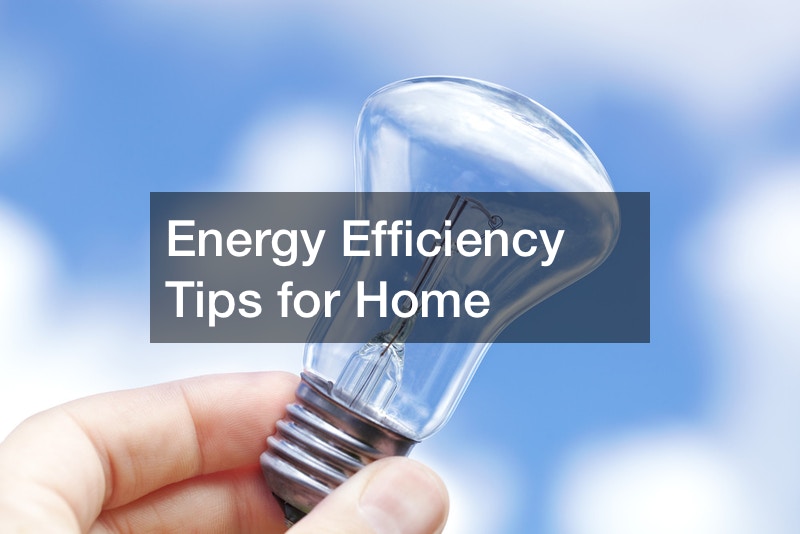
Apart from cost savings, the urge to be more energy-efficient stems from a desire to protect the environment from additional harm caused by climate change, water and air pollution, and the depletion of nonrenewable resources.
As a result, society continues to emphasize on sustainability, with many people making more tremendous efforts to reduce carbon emissions and reliance on limited natural resources.
Whether you want to live an eco-friendly lifestyle or save money on your monthly energy bills, a few easy changes to your home can help you reduce greenhouse gas emissions and improve indoor air quality while saving money. This article shares 20 tried and tested Energy Efficiency Tips for Home.
Conduct an Energy Audit
It is one of the essential Energy Efficiency Tips for Home as it will enable you to know your home’s inefficiencies, where energy is lost, and the exact steps to take. A qualified auditor will inspect your house to identify cost-cutting opportunities and improvement areas.
Motion-sensor lights
It’s always a good idea to conserve energy by switching off lights in rooms that aren’t in use. It’s understandable if children forget to do so while adults get busy and preoccupied from time to time. It might result in energy waste as well as higher power bills.
Motion-sensor lights might help you save money on the electricity bill. Furthermore, these lights are excellent, as security lights and outdoor lighting.
Seal the Windows

Sealing air leaks everywhere is one of the most straightforward energy efficiency tips for homes to adopt. Consider installing exterior siding around the frames of your windows if they are drafty. Apply a coating of silicone sealant to any cracks in your walls, or cover your windows with a layer of shrink film.</p>
You can also consult glass insert companies to assist in installing Pilkington K glasses (low emissivity-coated glasses) to your windows. The glasses allow heat from the sun to enter your home, helping you save energy. This energy-saving glass complies with all energy-saving requirements set forth by today’s building codes.
Dish Washer<
It would be best to run full loads while avoiding the misuse of your machine’s ‘rinse hold’ function for a few dirty dishes since it wastes a lot of hot water per use. Allowing them to air dry can also help you conserve power.
If the dishwasher does not have an automated air-dry setting, switch it off after the last rinse and open the door to allow the dishes to dry more quickly.
LED Lights
Home lighting systems account for up to 20% of overall energy consumption. You can save up to 10% on lighting energy by replacing energy-draining lighting like incandescent and halogen bulbs with more energy-efficient LED bulbs.
LEDs consume less energy than incandescent bulbs because their diode technology is more efficient. They also have a long life span, which means you will save money in the long run.
Switching off Electronics When Not Use
When most people are not using their electronic equipment, such as their televisions, microwaves, home theatres, and other devices, they leave them in standby mode.
Professional electricians can also confirm that electronic appliances continue to consume power when in standby mode. So, if you’re one of those people, turning them off at the power supply when not in use is a sure way to implement Energy Efficiency Tips for Home.
When you’re not using your chargers, unplug them since the average charger uses 0.26 watts when idle and 2.25 watts when charging a phone. One charger won’t have much impact, but several chargers left for a long time can account for 6% of your energy expenditure.
Solar Panel

Solar panel installation continues to gain popularity as one of the most helpful Energy Efficiency Tips for Home. It helps reduce the energy bill by up to 50% and eliminates your reliance on the grid system for power. Solar energy is also a clean source of energy that may make you qualify for tax benefits.
Insulation
Insulating your home is among the fantastic Energy Efficiency Tips for Home. The most considerable portion of a household’s energy is used in heating. When seeking residential roofing services, you can instruct your roofing contractor to insulate the roof to prevent heat loss.
Additional layers of batting insulation to your attic will also prevent hot and cold air from escaping. Get professional guidance on the optimum insulation of your attic from an expert roofing contractor since insulation helps in saving up to 20% on heating costs.
Kitchen Appliances
Switching to energy-saving kitchen equipment is one of the most effective energy efficiency tips for the home. Refrigerators, microwaves, ovens, and other kitchen appliances account for roughly 40% of overall energy consumption in a home.
You can save up to 15% on electricity by switching to energy-efficient kitchen equipment. Major electronics firms focus on making their kitchen products more energy-efficient annually.
If your appliances are older than 5 years, you may need to consider replacing them with new energy-efficient models. Also, look for energy-star items since they use 10% to 50% less energy than ordinary kitchen appliances.
Smart Heater
An ideal way to save energy with water heaters is to cover them with a specific insulating cover. This coat in the tank makes the water stay heated for 2 – 3 hours longer than usual, requiring the heater to turn on for extended periods. Similarly, we can insulate the water lines to keep the water at a high temperature for longer.
With the help of a programmer, you may save energy on your water heater. This feature is available on many models, and it allows you to schedule when the water heater will turn on, allowing you to turn it on before you need it. It is a cost-effective choice.
Replace your Computer

According to most computer experts, replacing your computer after four years is recommended. Consider replacing your desktop computer with a laptop, since they use 80% less electricity than desktop computers. Laptops typically have a maximum power draw of 60 watts, while most desktops have a top power draw of 175 watts.
HVAC System
Increasing the efficiency of your HVAC system (Heating, Ventilation, and Air Conditioning) is also among the essential Energy Efficiency Tips for Home to reduce your overall energy usage. It’s critical to replace the air filters every 30- 60 days to keep your air conditioner system running smoothly.
Your air conditioner system will have to put more effort into letting air pass through a dirty air filtering system, which will increase the power required to maintain the necessary temperatures and quality indoor atmosphere.
Apart from upgrading the air filters, here are additional Energy Efficiency Tips for Home HVAC systems.
1. Lowering the thermostat by one degree can save you up to 5% on your monthly energy expenditures. Installing a smart thermostat could improve the situation by lowering the temperature by 3 to 5 degrees when no one is at home, reducing your monthly utility bill.
2. Have your HVAC system inspected by a competent technician once a year and replace it with modern Energy-Star equipment if it requires frequent repairs or is over 15 years old.
3. Geothermal HVAC systems are the best energy-efficient systems since they cool and heat your home using energy from the earth’s surface rather than conventional fuel generators like coal, propane, and other fossil fuels.
Ceiling Fan
Another approach to Energy Efficiency Tips for Home in saving energy is to keep your house cool by using your ceiling fan. Turn your fan counterclockwise to create cold air without an air conditioner in the summer. When the weather warms up, turn on your ceiling fan to help disperse the cool air from your HVAC system in your home without turning on the air conditioner.
Ceiling fans can help you save money on heating as well as cooling. Spinning your fan clockwise during the cooler months might help move warm air from the ceiling downwards into the rest of the house without causing a breeze.
Hedges and Shrubs
Planting shrubs near your house will help insulate your external walls from heat and cold, similar to how trees provide shade to your home during the summer. Shrubs and hedges act as windbreaks, creating an air envelope that insulates external walls. You can plant hedges that grow well in your area a few meters from your walls for the best results.
Asphalt
Asphalt pavements and parking lots are eco-friendly since the materials utilized are recycled. The pavements only require a short time to dry, allowing for continued use. Environmental safety is assured because asphalt pavement discharges no chemical vapors.
When having pavements built in your home, hire a reputable construction firm to get quality asphalt services so that you won’t have to worry about maintaining them for a long time.
Showerhead
Installing low-flow showerheads increases your home’s water efficiency since they have a lower flow rate of 2.5gpm than 5gpm (gallons per minute) for most conventional showerheads.
Running Taps
Turn off the tap when shaving, brushing your teeth, or washing your face because a running tap can lose more than 4 liters of water each minute.
PlumbinHire a professional and affordable plumbing service provider to check and fix possible leakages like running toilets, constant faucet drips, and outside sprinkler systems. Regular maintenance of your home’s plumbing system will help you save approximately 30% of domestic water use.
Alternative Water Source
Having a well on your property with efficient well pump services will enable you to tap into groundwater, saving money on your metered water bill. You can also get water butts to collect and store rainwater which you can use to rinse your plants, wash the car, and eliminate the need for sprinklers in your garden.
Washing Machine
Washing machines use the second most amount of water in your home. Replace old models with energy-star certified washing machines that consume 40% less power. You should also avoid running your washer with half-loads of clothing. A whole load implies more clothing is washed at once, conserving water and power usage.
Greywater System
Any hot water flushed down carries energy in the form of heat with it. That means that as much as 80% of the energy used to heat the water in your home is lost. The heat recovery systems address this issue by absorbing the heat and using it to warm cold water before it enters the water heater or other water fixtures. It allows you to heat more water while also lowering the temperature of your water heater.
A greywater system enables you to reuse up to 65% of your domestic wastewater for lawn irrigation and toilet flushing tasks. If you’re building a new home, especially in a dry area, you should think about installing a greywater system.
Low-flow or Dual-flush Toilets
New toilets are available in a variety of water-saving designs, and they function as well as or better than previous versions while using less water. Toilets built after 1995 consume no more than 1.7 gpf (gallons per flush); however, toilets made before 1995 can use up to 5 gpf.
Consider a low-flow toilet, which uses not more than 1.3 gpf, if you decide to buy a new one or a dual-flush model. A dual-flush model has a light flush option that requires less than 1 GPF, and solid waste has a standard flush option that uses 1.6 gpf. These two types are highly efficient in common household water conservation.
Following these Energy Efficiency Tips for Home will help you save money on your overall utility bills. Fortunately, technological breakthroughs have made it possible to keep using your favorite gadgets and maintain your regular daily routines while saving money on energy bills.



